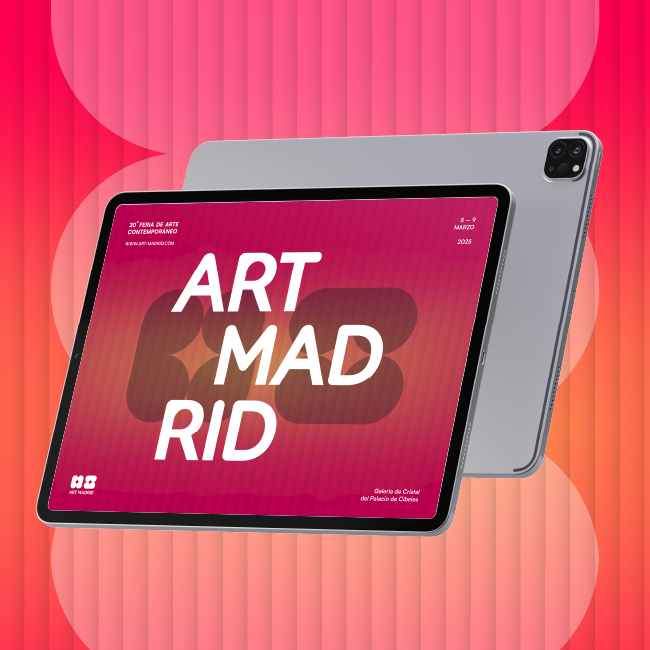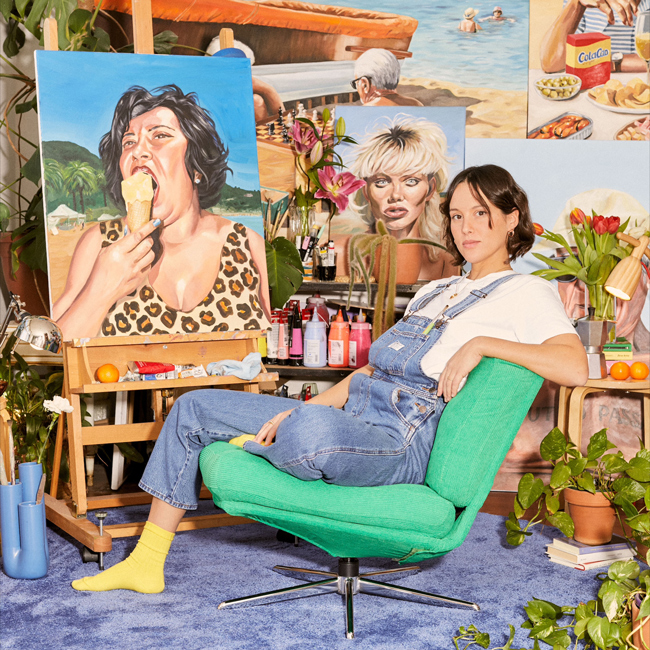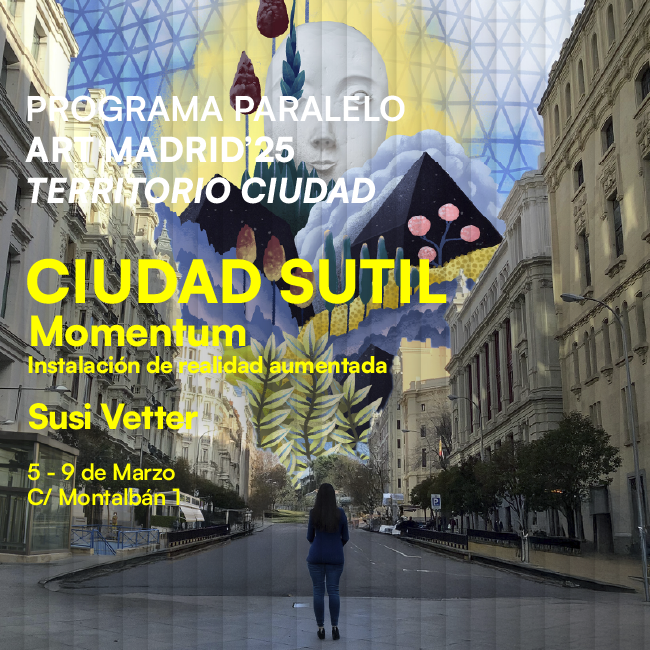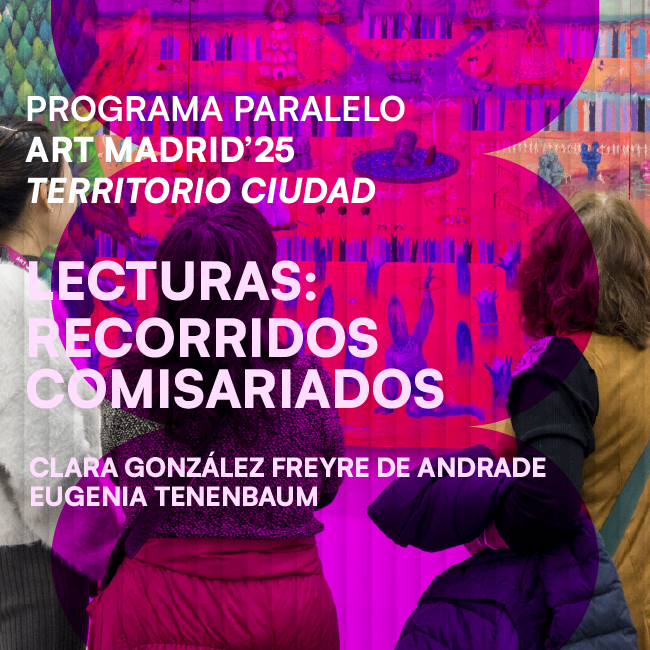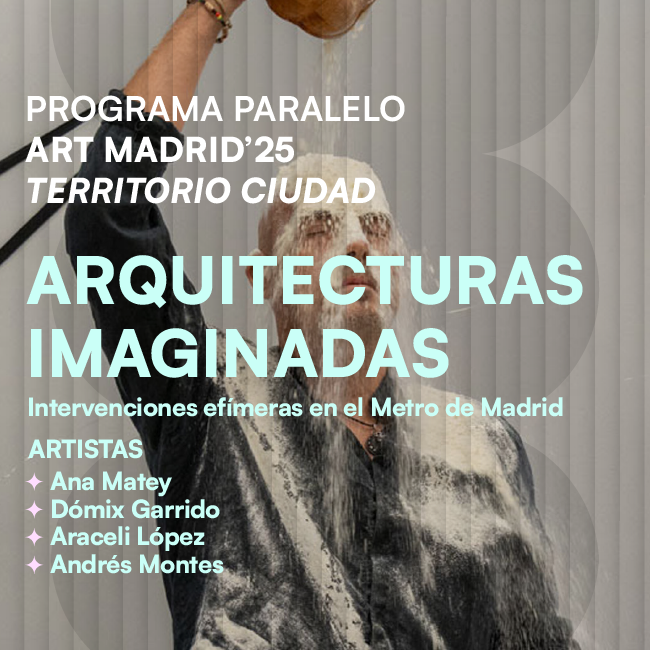DANIEL SCHWEITZER: THE FRACTAL GEOMETRY
Feb 17, 2024
art madrid

ARTE & PALABRA. CONVERSATIONS WITH CARLOS DEL AMOR
When you research Daniel Schweitzer (Germany, 1988), you come face to face with fractal geometry, and you may feel the panic of the unknown, the panic of entering terrain in which you are not comfortable. But you soon realize that Daniel uses geometry to help us fill the void. He uses repetition as a quest to reach an unattainable infinity. He is able to make sense of this concept and activate our sensory mechanisms. It provokes an interaction with the viewer, who forgets about fractals and enters an unknown but comfortable, friendly world. And when something is friendly, conversation and dialogue are born, which is the ultimate aim of a work of art, to build bridges between object and person, and for both to understand each other in a space that would be different if the work were not there. The work transforms the space, which will be different for each person. This is where the infinity of a perfect fractal is reached, in the infinite perceptions or sensations one can have in front of a work of art.
If you had to define your work in one sentence, what would it be?
I think that defining my work in a single sentence is somewhat reductionist. I believe that the beauty and richness of the work lies in the complexity of the set of elements, in the nuances. That is why, beyond a concrete definition, I find the conversation and reflection around the work much more interesting. Isn't that the function of art? To propose questions, reflections and points of view rather than concrete answers.
Having said that, there are a number of keys, concepts, languages and resources that have been the backbone of various projects that can provide a framework for approaching my work. For some time now I have been working with geometry from a variety of approaches as a way of thinking about the construction of space. Sometimes literally, sometimes in a more symbolic or poetic way. Through my work I am interested in constructing experiences and interactions with the viewer that take advantage of the specificity of materials and sculptural languages. But if forced to give an answer, I would say that my work is a compendium of lines, planes, folds, twists and movements that capture time and space.

Give me a hint, how do I look at your work: do I look at it standing up? Do I move?
You can look at it in many ways, but it is true that if you introduce movement into the way you look at the work, it becomes much more interesting. You introduce time and space, and in a way that movement changes the image, makes it stop being fixed or two-dimensional and becomes something much more changeable, richer. Movement allows you to approach the pieces in a much more spatial way. Movement also implies an active position for the viewer.
These elements are typical of the language of sculpture and are of particular interest to me because I work with them consciously. They allow me to open up the works to a space that is not "representational" but more in the realm of "literalness". This is the framework in which I am interested in working, where we move from the hieratic images of "representation" (which function inwards) to a realm of spatial and sensory relations, where the specificities of sculptural language are exploited. In this realm the object functions not only inwards but also outwards, in a much more relational space. This space allows for interaction between the object and the viewer. Here, movement allows for a richer and more complete form of contemplation, opening up to the discovery of perceptions, reflections and points of view that would otherwise be lost.
The idea of change seems to me to be very present in your creations. Each of them contains many, depending on the point of view. Do you think about the many possible points of view when you approach a new work?
Usually when I start a new work I start with an idea, sometimes a sketch, which is usually quite abstract. I like to have a non-coercive creative process. I like to have a mindful creative process. I like to be open to things happening. It's important for me to start from that basis, because the initial ideas often don't correspond to what is realized or simply don't work. Somehow you have to create a fluid conversation between what you have in your head and what comes out of your hands. This creative process has to be something active, intense, watchful. It can be a battle, a dance or a dialogue to get that object out and effectively transform that piece of sheet metal into something that is art. It's an almost magical process, an alchemy. I think it's also the part of the production that I enjoy the most, because it's where the suggestion is born. Let's say it's the most artistic part, the part that can't be delegated. The other 90% is pure hard work.
It is in this creative process that the various elements that make up the piece are defined. Not just "the" or "the" point of view, which is fundamental, but a series of plastic elements that have to do with the language itself, but also with the peculiarities of the material, the light, the composition, which in some way condition the point of view. But in any case, beyond thinking about the point of view, I like to think about the relationship with the spectator, that is, the body-object relationship. Here, planning the point of view opens up a much richer field of relationships. It is not the same, for example, to be confronted with a 2 meters piece as with a 50-centimeter piece. The point of view is different, but so is the whole experience.

And how important is emptiness? Is emptiness necessary to create and to live with what is created?
In contemporary sculpture we cannot ignore the importance of emptiness. The moment sculpture stepped off the pedestal, a completely different relationship was established in the dichotomy between fullness and emptiness. I would even go so far as to say that it represents a paradigm shift. The relationship between space-object-subject has passed a point of no return. I think this is something that needs to be taken into account when thinking about emptiness and its implications.
In my case, emptiness has the obvious component of giving form to volume, which you could say is a classical approach. But at the same time, emptiness allows me to work in a field of relationships. I find this part much more enriching and interesting because the object ceases to be an autonomous entity and is placed in a field of relationships where it coexists with the viewer and its surroundings. It is also the field in which I am interested in working. It is a reading where the spectator comes to the fore. Where light and space become important. Where we can talk about sensory relationships, about the construction of sensory space. All this is basically impossible without the void.
Is geometry friendly, something that can provoke emotions and stimulate the senses?
Traditionally, we could say that geometry in art is understood as something cold, especially if we take the references of Minimal Art of the 60s. But there are many other examples that suggest the opposite, such as Gego, with a much more sensitive geometric work. It is a poetic geometry linked to drawing. Another contemporary example is the work of Olafour Eliason, where he approaches geometry from a different perspective: there is color, there are atmospheres, there is light, there is space. These are works that play directly with the senses. I believe that in order for geometry to be friendly and to evoke emotions, it must be related and contextualized with other elements. In my case, I try to question the viewer to generate a more emotional approach or through the senses. In my latest projects I use light and movement as forms of interrelation.

Space is the word that comes up most often when people talk about you. How does space become an object and art at the same time?
Space is an obvious yet terribly elusive concept. It is an everyday thing that surrounds us, but when we try to conceptualize it, it remains an abstract, almost metaphysical realm. It is invisible and we only become aware of it when we can physically locate it or when it physically affects us. In my case, I am interested in space not as something measurable by "physics" or as something mathematical, but as a direct result of the body. As Donald Judd would say, "space is something that happens". That is, we speak of space as experience. In this sense the body is the center and space unfolds as an experience. I like to think of space in these terms because in this way point of view matters and our actions matter. Otherwise we are just a coordinate in an infinite space. I think it is essential to be aware of this fact. And in one way or another, my work approaches this reflection, sometimes poetically, sometimes metaphorically, and sometimes quite literally.
A very clear example is my recent work with holographic paint. This is painting that breaks down light into the visible spectrum, so that the color of the piece is transformed directly by the viewer's perspective and movement. They are pieces where the color literally changes depending on your point of view. For me it is a way of involving the viewer and inviting them to reflect on what this sensory construction of space implies.

Fractal (fractal geometry) comes from the Latin fractus which means something like broken... Can I define your art as broken art?
The word broken leads us to something broken or weak. In my case I'm much more interested in thinking of fractal as a working methodology. As a constructive system that responds to its own logic. It allows me to create complex shapes from very simple elements. I often use the 2D simplex (a triangle) or the 3D simplex (a tetrahedron) because they respond very well to this approach. The simplex is a minimal geometric element. The tetrahedron, for example, is the minimal element to build a volume, because if we eliminate any point, we lose three-dimensionality. The same happens with the triangle, if we eliminate any point we lose the plane. They then become the minimum constructive elements from which we can build infinite shapes and volumes. It is as if they were the letters of an alphabet, which on their own have no value, but when put together in the right way they become meaningful. I use these minimal elements to construct plastic languages. This allows me to create complexity from very simple elements. It allows the simple and the complex to coexist.
There are ideal and infinite fractals, which are usually mathematical, but there are also finite and natural fractals, like clouds, trees, a mountain range... In a way, every artist is a fractal, right?
I think the key is how you understand and position yourself in such a broad subject. In my case, although it may seem contradictory, I have never been interested in the mathematical part of the concept. I came to the idea of fractals by looking for ways to work with space. That is, as a constructive system or working method. I'm interested in fractals because they generate systems that can be repeated and expanded, but which generate different proposals. We can find good examples of this in nature. A leaf, for example, has a geometric system that repeats and expands within the logic and functionality of the hole itself. This means that each leaf is unique, but retains the same system that responds to its own logic.
This is the thinking I try to apply to my work. Irrespective of the mathematical measurements, the pieces must function according to their own logic and system. But I believe that geometry must be at the service of the senses, of physical experience. That's why I'm not interested in numbers: they're cold, rational and predictable. Art is unpredictable. So the challenge is to make the pieces work. That is to say, to go from an anodyne sheet of metal to an interesting object capable of questioning the viewer.

Where is your art going, towards infinity?
It's hard to say. I came out of my studies with figuration and I've ended up with geometric repetitions. Although they are two things that have nothing to do with each other, there is a common thread, a way of going from figuration to geometry.
This change has to do with the progressive incorporation of new elements of interest that have led me to work on the body from representation to questioning the spectator's body with fractal geometry.
Now I am aware of the danger of working with fractal repetitions, or the repetition of different geometric modules, because from a theoretical point of view they can be infinitely extended. But if we introduce the spectator into the equation, this idea is immediately truncated. I may be redundant, but the body (the spectator) is still the measure of the world, just as it is the measure of my work, because it is the only thing that can give meaning to a proposal. When we introduce the dimension of the body, "natural" and "sensual" limits are automatically generated in the work. For me, it is a fundamental and constant reference in order not to get lost in an infinite sea of fractal repetitions.







